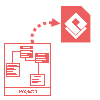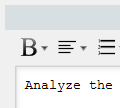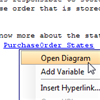Unable to run Visual Paradigm after upgrading to Mac OS X 10.10 Yosemite
Mac OS X user may receive the following message when trying to run Visual Paradigm after upgrading their Mac OS to the latest version 10.10 Yosemite.
Mac OS X user may receive the following message when trying to run Visual Paradigm after upgrading their Mac OS to the latest version 10.10 Yosemite.
 VP Server is an integrated server providing the facilities including Teamwork operation support, Hosting of floating license as well as Centralized update server. The default VP Server package bundled with a web server where you can bring it up by simply download, unpack and run. The default package also allow user to have a seamless server upgrade, by simply upload a webapp package to server and let the server do the rest. In some situation user would prefer to run VP Server on his own Java application server, i.e. already have a Tomcat for other services in the company. With this setup the procedures for upgrade VP Server will be a bit difference. This article will teach you the procedures to update your VP Server which is being deployed to a stock Tomcat. Read more
VP Server is an integrated server providing the facilities including Teamwork operation support, Hosting of floating license as well as Centralized update server. The default VP Server package bundled with a web server where you can bring it up by simply download, unpack and run. The default package also allow user to have a seamless server upgrade, by simply upload a webapp package to server and let the server do the rest. In some situation user would prefer to run VP Server on his own Java application server, i.e. already have a Tomcat for other services in the company. With this setup the procedures for upgrade VP Server will be a bit difference. This article will teach you the procedures to update your VP Server which is being deployed to a stock Tomcat. Read more
 It is often that you have quite a number of models being reused across projects. Duplicating those models across projects would lead to a management nightmare in which you will need to update all those models on all projects when you need to make changes on it. By creating reference projects in Visual Paradigm Standard Edition, you can define those model elements as a global project, which can be reused by other projects. The reference project not only works locally on your machine, but also works in team collaboration environment where it can be shared across teammates. In this article we will teach you how to migrate your local working projects as well as your referenced projects into VPository environment. Read more
It is often that you have quite a number of models being reused across projects. Duplicating those models across projects would lead to a management nightmare in which you will need to update all those models on all projects when you need to make changes on it. By creating reference projects in Visual Paradigm Standard Edition, you can define those model elements as a global project, which can be reused by other projects. The reference project not only works locally on your machine, but also works in team collaboration environment where it can be shared across teammates. In this article we will teach you how to migrate your local working projects as well as your referenced projects into VPository environment. Read more
In an ERD, when you represent the columns that exist in entities, you might only want to show their names but not any other property like their types since datatype is usually not required in early communication of data structure but is only required when implementing a database. In order to simplify an ERD and to avoid giving wrong information, you can hide the datatype, so that only the column names are left. For your convenience, Visual Paradigm supports hiding the datatype of columns, please follow the simple steps below. Read more
Visual Paradigm offers 3 types of license model – single seat license, floating license and subscription license (SaaS). Customers can pick the license model that best fit their usage when they purchase license.
Knowing the type of license is useful or sometimes essential. But as an end user you may not know the type of license you are using, just because you are not the one who place the order. This article will show you how to find out the type of license you are using. Read more
 For every model element, there is a description property that allows you to describe detailed information about individual element, so that readers can understand the intended use, intended behavior and other important information. For example, specific implementation guideline can be written in a UML class or class diagram, and precautions can be written in a BPMN task in a business process diagram.
For every model element, there is a description property that allows you to describe detailed information about individual element, so that readers can understand the intended use, intended behavior and other important information. For example, specific implementation guideline can be written in a UML class or class diagram, and precautions can be written in a BPMN task in a business process diagram.
Sometimes, we may not have the information we need to enter in the description at the time the model element is being created. We may leave it first and enter it later on. But then the problem comes: After several days or weeks, how do I remember which shapes in a diagram has description missing? To check shape-by-shape is time-consuming…
In this article, we will show you how to indicate in diagram shapes that has description entered. This allows you to concentrate on shapes that have no description entered. Besides, it allows readers to check and read the description of shapes only when description has been entered which makes the diagram more legible.
 When you copy and paste formatted text into a description editor in Visual Paradigm, it automatically brings along the formatting properties. This sounds reasonable and is quite a nice behavior if you really want to keep the style of text contents. However, there are several reasons why you might not want to keep the formatting. First, when you copy from web page, it may bring along crappy HTML contents, say the hidden table borders and layers. In fact, when CSS is widely used in most of the modern websites, what you copy from a webpage is not necessarily what you can get when pasting without the existence of the CSS. Second, you may not want to mix up the style of text in your description with the source. Third, although the crappy formatting properties may look invisible in the description editor, they may affect the content in generated documentations. After all, to clear those formatting tags is time consuming and error prone.
When you copy and paste formatted text into a description editor in Visual Paradigm, it automatically brings along the formatting properties. This sounds reasonable and is quite a nice behavior if you really want to keep the style of text contents. However, there are several reasons why you might not want to keep the formatting. First, when you copy from web page, it may bring along crappy HTML contents, say the hidden table borders and layers. In fact, when CSS is widely used in most of the modern websites, what you copy from a webpage is not necessarily what you can get when pasting without the existence of the CSS. Second, you may not want to mix up the style of text in your description with the source. Third, although the crappy formatting properties may look invisible in the description editor, they may affect the content in generated documentations. After all, to clear those formatting tags is time consuming and error prone.
Account for the reasons above, it would be nice to have certain ways to paste text without including formatting properties, which means, to paste as plain text. In Visual Paradigm, the “Paste without formatting” function is provided to serve this purpose.
 When you are documenting your model, you may come across the situation where you want to make a reference to certain diagram in the project to help you explain an idea or to give reader supplementary information they may find useful. For example, you may want to add into the description of a class, a note to tell the developers that if they want to know more about the state change of the class, refer to certain state machine diagram. While the reference feature allows you to establish formal and contractual reference between model elements and diagrams, the reference function you can find within the description editor enables you to add diagram link into any part within a description, casually and informally. Such a diagram shortcut enables reader to jump from description to a diagram, which makes navigation much easier.
When you are documenting your model, you may come across the situation where you want to make a reference to certain diagram in the project to help you explain an idea or to give reader supplementary information they may find useful. For example, you may want to add into the description of a class, a note to tell the developers that if they want to know more about the state change of the class, refer to certain state machine diagram. While the reference feature allows you to establish formal and contractual reference between model elements and diagrams, the reference function you can find within the description editor enables you to add diagram link into any part within a description, casually and informally. Such a diagram shortcut enables reader to jump from description to a diagram, which makes navigation much easier.
 In relational database, records are identified by a unique value. We call this value the primary key. Some databases allow to control how this unique value is being generated by defining the sequence. In this article, we will show you how to model the sequence with Visual Paradigm and use as the ID Generator for your database tables.
In relational database, records are identified by a unique value. We call this value the primary key. Some databases allow to control how this unique value is being generated by defining the sequence. In this article, we will show you how to model the sequence with Visual Paradigm and use as the ID Generator for your database tables.
 Last week, we showed you how to assign entities in an ERD to a schema. One of our users ask if there is any way to group entities in a logical manner, rather than setting the schema property reserved for physical database.
Last week, we showed you how to assign entities in an ERD to a schema. One of our users ask if there is any way to group entities in a logical manner, rather than setting the schema property reserved for physical database.
The answer is yes. You can make use of model or UML package to store and categories the entities in logical groups. The grouping can be seen in both the Model Structure and diagram. In this article, we will show you how to group entities in ERD database designer. In order to perform the steps described in this article, make sure you have Visual Paradigm installed.
